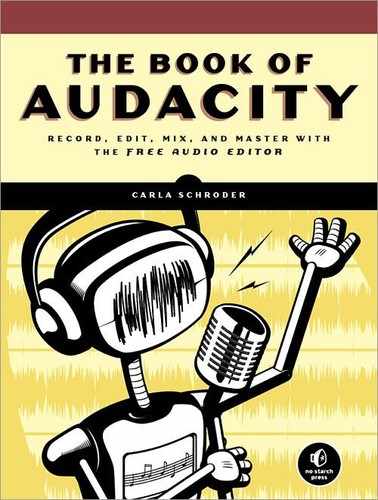Your first step on a new Audacity project should always be to name, it using File > Save As. Then you can press ctrl-S periodically to save changes or use File > Save. In addition to the .aup file, which is the project’s master metadata file, Audacity creates a directory that holds the associated audio files. You can view these in your file manager; there will be many subdirectories full of files with the .au extension.
Select File > Open to add an existing audio file to a new, empty project. After that, select File > Import to add more files. Selecting File > Open in a nonempty project opens the file in a new window.
Audacity projects are optimized for use as fast workspaces and are not suitable for archival storage. There’s no snapshot mechanism for preserving your work at different stages, and users have reported losing data when projects become corrupted. I use a belt-and-suspenders approach: I make backups of my Audacity project files, and I also make studio master files in WAV format, because each approach has its advantages and weaknesses. First we’ll look at a method for saving Audacity projects at different stages, and then we’ll look at how to make studio masters in WAV format.
You can create something akin to project snapshots by creating multiple Audacity projects from your original project. First, make a directory to hold related projects so they don’t get mixed up or lost. Then select File > Save Project As and give the project a name to help you remember what’s in it, such as Summer-Festival-1, Summer-Festival-2, or something more descriptive like Summer-Festival-No-Banjos or Summer-Festival-Mondo-Banjos. When you do this, you’ll see a dialog like Figure 1-18. The crucial question here is “Copy audio from the following files into your project to make it self-contained?” Say yes by clicking the Copy All Audio into Project (Safer) button. This duplicates project files and uses more disk space, but it is the safest option. Sharing files across multiple projects saves disk space, but the headaches aren’t worth it because changes in one project affect all projects. Even worse, you lose redundancy, which is your insurance against any one project becoming damaged and unusable.
You can control this behavior in the Edit > Preferences > Projects dialog: When saving a project that depends on other audio files. This offers three choices: “Always copy all audio into project,” “Do not copy any audio,” or “Ask user.”
To make a high-quality studio master WAV file, export your project by selecting File > Export. You can do this as many times as you want during your work on a project, creating multiple masters to preserve your work at different stages (or until you run out of disk space!). Then you can import a WAV master whenever you want for further editing, and you can export to any other audio format from your WAV master. This also gives you the option of importing your WAV master into another audio-editing program, which you can’t do with Audacity’s project files.
The default export quality setting for WAVs is 16-bit integer, which is not the highest quality. Audacity’s default recording quality setting (select Edit > Preferences > Quality) is a sampling rate of 44.1 kHz and a bit depth of 32-bit float. (Audacity terminology refers to bit depth as sample format, but bit depth is the correct term.) You can create a high-quality studio master by exporting to 32-bit float WAV. Follow these steps:
Select File > Export.
Select Save as type: Other uncompressed files.
Click Options and then select Header: WAV (Microsoft) and Encoding: 32 bit float.
You will see a window like the one shown in Figure 1-19.
The resulting file is not a playable WAV file, except in Audacity and other audio editors and digital audio workstations that use 32-bit float for editing. However, it is great for studio masters because you can import and edit 32-bit float WAVs with very little loss of quality and export them to other audio formats: 16- and 24-bit WAV, Ogg Vorbis, MP3, FLAC, and so on. WAV supports a maximum of 32 tracks in a single file.
However, this has its drawbacks too. It works fine when you have only a few tracks to manage—my limit is four—because Audacity does not save the track names but instead renames all of them with the WAV filename. Let’s say you have a four-track recording and the tracks are named vocal, piano, violin, and vocal2. Export this project to a single WAV file and name it testwav.wav. When you import testwav.wav into Audacity, all four tracks are renamed testwav 1.wav, testwav 2.wav, and so on. It also makes tracks 1 and 2 Right and Left, even if they were originally mono tracks. Figure 1-20 shows the before and after.
Figure 1-20. Exporting your project to WAV (on the left is the original project before exporting to WAV, and on the right is shown what happens when the WAV is imported back into Audacity)
You still have all of your individual tracks, but you lose the track names. On multitrack projects, I rely very much on track names to stay organized, so combining them all into a single WAV file doesn’t work for me.
For projects that have more than four tracks, I prefer to save each track as a separate WAV file. To do this, select the tracks you want to export and then select File > Export Multiple. (We will discuss selecting tracks in the next section.) Each track will be saved as a separate file, and the track name will become the filename of the corresponding file. When I do this, I put them in their own project directory so they don’t get mixed up with other projects.



